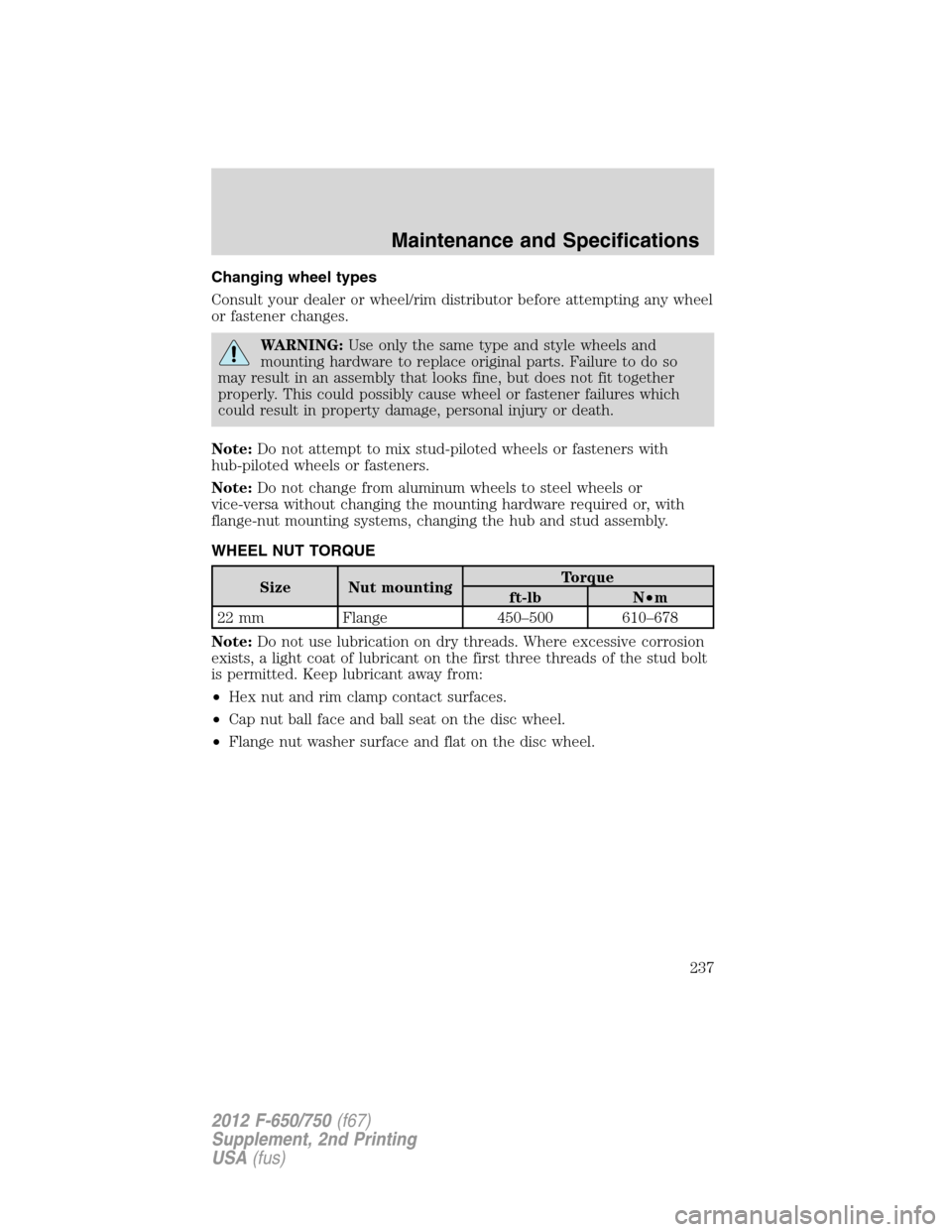Page 237 of 306

Changing wheel types
Consult your dealer or wheel/rim distributor before attempting any wheel
or fastener changes.
WARNING:Use only the same type and style wheels and
mounting hardware to replace original parts. Failure to do so
may result in an assembly that looks fine, but does not fit together
properly. This could possibly cause wheel or fastener failures which
could result in property damage, personal injury or death.
Note:Do not attempt to mix stud-piloted wheels or fasteners with
hub-piloted wheels or fasteners.
Note:Do not change from aluminum wheels to steel wheels or
vice-versa without changing the mounting hardware required or, with
flange-nut mounting systems, changing the hub and stud assembly.
WHEEL NUT TORQUE
Size Nut mountingTorque
ft-lb N•m
22 mm Flange 450–500 610–678
Note:Do not use lubrication on dry threads. Where excessive corrosion
exists, a light coat of lubricant on the first three threads of the stud bolt
is permitted. Keep lubricant away from:
•Hex nut and rim clamp contact surfaces.
•Cap nut ball face and ball seat on the disc wheel.
•Flange nut washer surface and flat on the disc wheel.
Maintenance and Specifications
237
2012 F-650/750(f67)
Supplement, 2nd Printing
USA(fus)
Page 266 of 306
Daily owner checks
U.S. Department
of Transportation,
Federal Highway
Administration
requirements
(ensure that the
entire system is
functioning
properly)Service brakes
Parking brake
Steering mechanism
Lighting devices and reflectors
Tires
Horn
Windshield wipers
Rear vision mirrors
Wheels and rims
Emergency equipment
Every oil change
EngineInspect engine cooling system hoses, clamps and
protection.*
Inspect drive belts.
Exhaust systemInspect entire exhaust system (including the inlet
pipe(s), muffler(s), outlet pipe(s), clamps and
fasteners) for holes, leakage, breakage, corrosive
damage and separation from other components.
Adjust, service or replace with the same or the
equivalent part. (Also a noise emission control
service.)
SuspensionTighten the front and rear spring U-bolts to the
specified torque.
Driveline and rear
axleLubricate the U-joints and the slip yoke.
Scheduled Maintenance Guide
266
2012 F-650/750(f67)
Supplement, 2nd Printing
USA(fus)
Page 268 of 306

Periodic component/system checks
The following are vehicle checks that should be made periodically either
by the owner or a qualified technician. It is recommended that
deficiencies be brought to the attention of your dealer or another
qualified service outlet as soon as possible in order that advice regarding
the need for service or replacement can be obtained.
Frequency Recommended action
At every engine start up Check ABS lamp operation
After first 500 and 1000 miles (800
and 1600 km), then every 500 and
1000 mile (800 and 1600 km)
interval after tire
removal/replacementTighten the wheel mounting nuts
to the specified torque. Refer to
Wheelsin theMaintenance and
Specificationschapter
At least twice annually Clean body/door drain holes
As required Clean windshield wiper blades
Observation Maintenance operation
Insufficient power shown in loaded
practice stopInspect the automatic slack
adjuster function
Subpar vehicle handling qualities Check the operation of the brakes,
clutch and steering
(1),(2)
Excessive noise from under the
cab or engine compartmentInspect the vehicle for missing,
damaged or mislocated noise
shields
Excessive engine noise Check the engine performance and
the engine governor
Engine overheats; excessive fan
noise; fan constantly runs at high
speed or wobbles due to worn
bearingsInspect the fan, fan shroud and fan
clutch
Excessive exhaust noise; smell of
exhaust fumes is experiencedInspect the entire exhaust system
for holes, leaks, breakage,
looseness and corrosive damage
Scheduled Maintenance Guide
268
2012 F-650/750(f67)
Supplement, 2nd Printing
USA(fus)